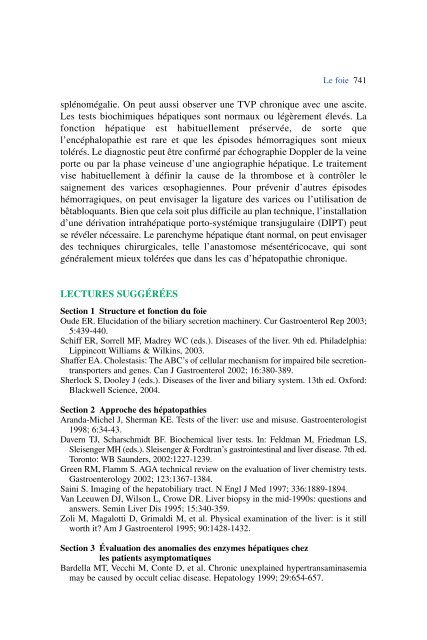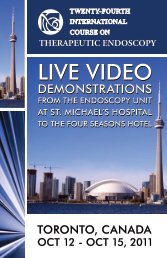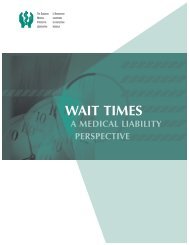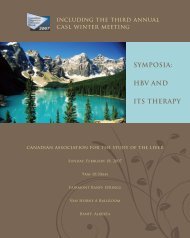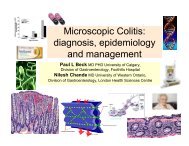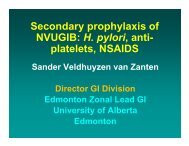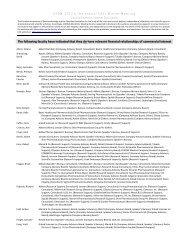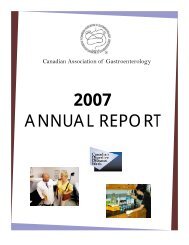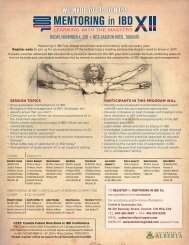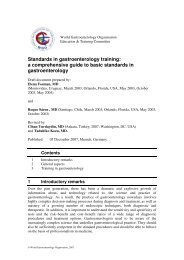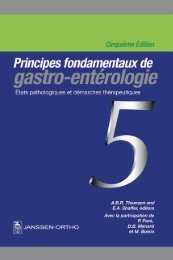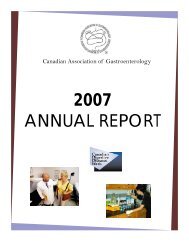Untitled - The Canadian Association of Gastroenterology
Untitled - The Canadian Association of Gastroenterology
Untitled - The Canadian Association of Gastroenterology
Create successful ePaper yourself
Turn your PDF publications into a flip-book with our unique Google optimized e-Paper software.
Le foie 741<br />
splénomégalie. On peut aussi observer une TVP chronique avec une ascite.<br />
Les tests biochimiques hépatiques sont normaux ou légèrement élevés. La<br />
fonction hépatique est habituellement préservée, de sorte que<br />
l’encéphalopathie est rare et que les épisodes hémorragiques sont mieux<br />
tolérés. Le diagnostic peut être confirmé par échographie Doppler de la veine<br />
porte ou par la phase veineuse d’une angiographie hépatique. Le traitement<br />
vise habituellement à définir la cause de la thrombose et à contrôler le<br />
saignement des varices œsophagiennes. Pour prévenir d’autres épisodes<br />
hémorragiques, on peut envisager la ligature des varices ou l’utilisation de<br />
bêtabloquants. Bien que cela soit plus difficile au plan technique, l’installation<br />
d’une dérivation intrahépatique porto-systémique transjugulaire (DIPT) peut<br />
se révéler nécessaire. Le parenchyme hépatique étant normal, on peut envisager<br />
des techniques chirurgicales, telle l’anastomose mésentéricocave, qui sont<br />
généralement mieux tolérées que dans les cas d’hépatopathie chronique.<br />
LECTURES SUGGÉRÉES<br />
Section 1 Structure et fonction du foie<br />
Oude ER. Elucidation <strong>of</strong> the biliary secretion machinery. Cur Gastroenterol Rep 2003;<br />
5:439-440.<br />
Schiff ER, Sorrell MF, Madrey WC (eds.). Diseases <strong>of</strong> the liver. 9th ed. Philadelphia:<br />
Lippincott Williams & Wilkins, 2003.<br />
Shaffer EA. Cholestasis: <strong>The</strong> ABC’s <strong>of</strong> cellular mechanism for impaired bile secretiontransporters<br />
and genes. Can J Gastroenterol 2002; 16:380-389.<br />
Sherlock S, Dooley J (eds.). Diseases <strong>of</strong> the liver and biliary system. 13th ed. Oxford:<br />
Blackwell Science, 2004.<br />
Section 2 Approche des hépatopathies<br />
Aranda-Michel J, Sherman KE. Tests <strong>of</strong> the liver: use and misuse. Gastroenterologist<br />
1998; 6:34-43.<br />
Davern TJ, Scharschmidt BF. Biochemical liver tests. In: Feldman M, Friedman LS,<br />
Sleisenger MH (eds.). Sleisenger & Fordtran’s gastrointestinal and liver disease. 7th ed.<br />
Toronto: WB Saunders, 2002:1227-1239.<br />
Green RM, Flamm S. AGA technical review on the evaluation <strong>of</strong> liver chemistry tests.<br />
<strong>Gastroenterology</strong> 2002; 123:1367-1384.<br />
Saini S. Imaging <strong>of</strong> the hepatobiliary tract. N Engl J Med 1997; 336:1889-1894.<br />
Van Leeuwen DJ, Wilson L, Crowe DR. Liver biopsy in the mid-1990s: questions and<br />
answers. Semin Liver Dis 1995; 15:340-359.<br />
Zoli M, Magalotti D, Grimaldi M, et al. Physical examination <strong>of</strong> the liver: is it still<br />
worth it? Am J Gastroenterol 1995; 90:1428-1432.<br />
Section 3 Évaluation des anomalies des enzymes hépatiques chez<br />
les patients asymptomatiques<br />
Bardella MT, Vecchi M, Conte D, et al. Chronic unexplained hypertransaminasemia<br />
may be caused by occult celiac disease. Hepatology 1999; 29:654-657.


